Digital Transformation: A Comprehensive Guide for any Business
In this blog, we will be discussing what the Digital Transformation process is in business and how Digital Transformation technologies can impact your business growth. At the end of this blog, you will be able to understand the benefits, challenges, and solutions to ensure that your transformation strategy is the best and can bring you success. Let us understand what Digital Transformation services mean to your business.
What is Digital Transformation? What does it do?
Digital transformation is the integration of technology into all aspects of a business, resulting in fundamental changes to its operations, customer experience, and value proposition. Digital transformation enables business models and revenue streams to enhance operational efficiency and agility and improves customer engagement and loyalty.
Overview of Key Digital Transformation Technologies
Digital transformation encompasses the use of digital technologies to fundamentally change business operations, models, and customer experiences. The process involves the integration of emerging technologies to optimize business processes and workflows. This blog outlines several Digital Transformation Technologies that organizations are leveraging to drive digital transformation.
Cloud computing:
Cloud computing has become a critical technology in Enterprise Digital Transformation. It enables businesses to store, access, and process data remotely via the Internet. With cloud computing, businesses can improve operational efficiencies, reduce costs, and enhance workforce collaboration.
Artificial intelligence and machine learning:
Artificial and machine learning are critical technologies in digital transformation. They enable businesses to analyze the vast amount of data in real time, identify patterns and insights, and automate repetitive processes. With AI (Artificial Intelligence) and ML (Machine Learning), businesses can optimize productivity, reduce costs, and deliver personalized customer experiences.
Internet of Things (IoT):
The Internet of Things has become important in digital transformation. It is a network of interconnected devices that can communicate and exchange data with each other. With IoT solutions, businesses can collect data remotely and use it to optimize operations, enhance customer experiences, and develop new revenue streams.
Blockchain:
Blockchain technology has become an important technology in digital transformation. It provides a secure and transparent way to store and transfer data, making it ideal for financial transactions, supply chain management, and other processes. With blockchain, businesses can improve transactional efficiency, increase transparency, and reduce costs.
Robotic Process Automation (RPA):
Robotic Process Automation (RPA) has become a critical technology in digital transformation. It enables businesses to automate routine and repetitive tasks, reducing the need for human intervention. With RPA, businesses can optimize productivity, reduce costs, and enhance workforce and collaboration.
Augmented, Virtual & Mixed Reality:
Augmented and virtual reality enables businesses to create immersive experiences for customers and employees, enhancing engagement and productivity. With AR/VR, businesses can improve training and development, visualize products, and enhance the customer experience. Moreover, mixed reality serves as a bridge between the physical and digital worlds, providing limitless possibilities for digital transformation.
Digital Transformation Trends
Digital transformation is essential for businesses to survive and succeed in today’s environment. It enables businesses to become more agile and responsive to market trends and customer needs. It also provides greater efficiency, cost savings, and the creation of new revenue streams. Additionally, digital transformation provides a more personalized and convenient customer experience. Therefore, businesses must embrace digital transformation and leverage technology to remain competitive in the future.
Deliver more machine learning to production with MLOps (machine learning operations) and ModelOps.
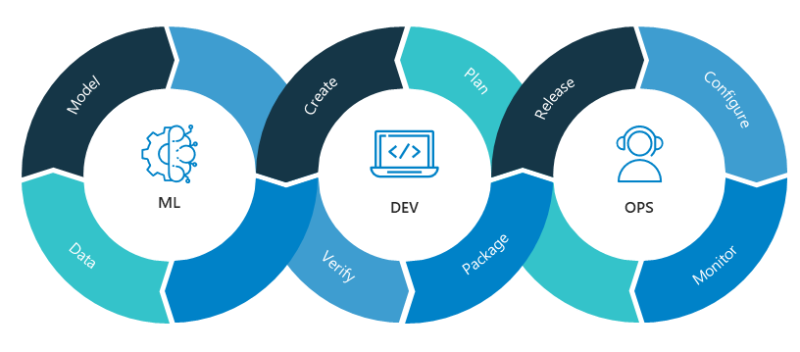
MLOps (machine learning operations) is the process of moving machine learning models into production with the help of data scientists, DevOps engineers, etc.
MLOps increases productivity, Repeatability, Reliability, Auditability, Data, and model quality of machine learning models.
If needed, MLOps and ModelOps can automate the entire workflow of the ML model. It automates the model lifecycle with the help of artificial intelligence algorithms.
Embrace AIOps (AI operations) to support multi-cloud and microservices.
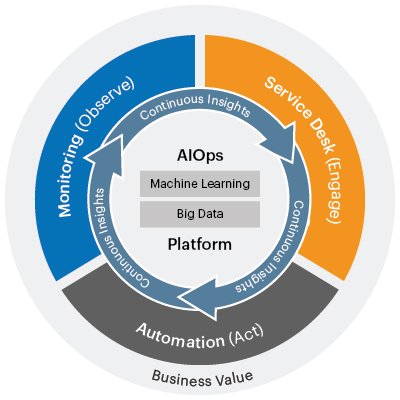
AIOps comes with advantages such as an increase in Savings On cloud costs. It also helps in the identification and resolution of problems faster and improves the performance of your applications. It eliminates recurring problems by automating complex and time-consuming processes with precision.
Also Read: Key Trends of Digital Transformation in Healthcare
The Future of Enterprise Digital Transformation
The global Digital Transformation consulting services market is estimated to grow with a CAGR (Compound Annual Growth Rate) of 10% from 2022 to 2031. There is significant market growth in every sector.
Digital transformation statistics show that the world is changing. According to the experts, approximately 85 to 90 percent of new enterprise apps will include AI technology by 2025.
70 percent of customer interactions will include emerging technologies such as cloud computing, Internet of Things, etc. Digitization of processes will mean a shift in people’s responsibilities and roles. Most companies are planning to invest more in IT (Information Technology) to gain an advantage.
Five Essential Elements of Digital Transformation
1. People:
We understand that we need data to transform your business with digital transformation technologies, and we are getting it from the people. To ensure the success of any business, we need employees, clients, and consumers and importantly, effective communication among all of them. We understand that you should not consider modern technologies when your organization or business is small. But what is your business and thousands of employees and clients working together? Then you need some technologies that may help you to complete your daily tasks to save you time. You can consider people as your first step toward digital transformation.
2. Data:
The next step to ensure the success of your digital transformation is valuable data. Most companies can extract valuable information and use it to deliver the best of their services to their clients. This customer data is helping companies to add more personalization to their information. Big giants such as Amazon, Flipkart, and many more are using this data to understand, align, and then take some action for the customers. On the other hand, you also need to understand that if you want to transform your business digitally, you need to enhance your vision toward online and offline data.
The data-driven transformation brings many advantages such as new business opportunities, redefined processes, deeper insights into customer behavior, and many more.
3. Insights:
Getting insights from the data is the third crucial element in digital transformation. Data is of no use if we are unable to extract the information from it. These insights help your business to grow. Most companies are still dealing with inappropriate strategies to extract insights from the data and hence are failing in the race to become the pioneer in their industries. To extract meaningful information from the data you need a system, a model, a framework, or data science and analytics. Now, here comes the technologies that will help you to track the insights from your data.
4. Actions:
Now, you understand that insights, data, and predictions are crucial factors in digital transformation. But most important is the decision that you as a leader of an organization are taking to ensure the success of your business. Artificial intelligence can make your predictions, data gives you insights about the liking and disliking of your product. But the important thing is how you are taking these insights to decide your future actions. For example, what do you do if you come to know that your product is not doing well for the customers,
Do you change your development process or marketing process? Here you need to be smart and put your experience into consideration so that you can change or update some processes towards the growth of your business.
5. Results:
Now, this is the final stage of the digital transformation process. In this stage, you will be determining the impact of the process on your business. In this iterative process, you can determine your results in two ways, through metrics and by the qualitative analysis of your business. By these metrics, you can ensure the rate of customer satisfaction, employee productivity, revenue growth, and retention.
Also Read: Important Practices For A CIO To Go Digital Transformation
Digital Transformation Challenges and How to Overcome Them?
1. Lack of organizational change management strategy
You need to work on the following points to ensure the best organizational management strategy.
i. Planning:
To make a proper plan you need to understand the existing process and strategies. You need to define your goals and then align them with your organization’s vision. You need to develop a detailed plan regarding the processes, and the number of resources needed, along with all the crucial points that need to be planned for a particular process. This is a crucial step as all your next steps will depend on how you plan various things.
ii. Start with Upper Management:
Upper management levels are taking final decisions about investments, the number of resources required, and processes.
After finalizing the above-mentioned areas, upper management shares their decisions with the team. They should explain the changes they decide to integrate into the processes and what challenges and concerns there are that the organization needs to deal with.
iii. Create a Roadmap:
Then you need to create a roadmap that helps your employees to understand the entire journey in detail. A roadmap must contain the deadline of every process.
iv. Monitor and Measure: You must take some measures to evaluate the success of your efforts. You can also have a detailed discussion regarding this with your colleagues. This will also ensure that all your teammates are on the same page.
2. Upskilling
Organizations understand that they need to hire experienced and skilled employees to ensure the growth of their business. Also, employees need to be trained frequently with the advancement in the processes. If needed, the organization should invest in attracting skillful employees to fulfill the organization’s needs.
3. Security Concerns
To deal with security concerns, organizations must invest in updating security policies and adopting new tools and technologies. Technology that is involved in digital transformation such as blockchain and cloud computing can ensure the security of your data.
4. Budget constraints
Digital transformation requires a significant investment initially. You can create a financial roadmap to ensure everything such as your priorities, goals and needs, strategies, timelines, planned outcomes, return on investments, etc. are in line.
5. The continuous evolution of Customer needs
Your services and processes must be updated sometimes. One of the main reasons for this is that customers are always looking for the best services. That means your services need to be advanced as per your customer demands. Digital transformation is changing the customer experience fundamentally. So, you need to use modern technologies in the best way you can for your customers.
Digital Transformation Strategies
It has become a top priority for businesses to remain competitive and relevant in today’s digital age. There are countless ways in which digital technology is changing the way we work and interact with each other. To succeed, in digital transformation, businesses need to adopt comprehensive strategies that integrate technology, data, and people in the right way.
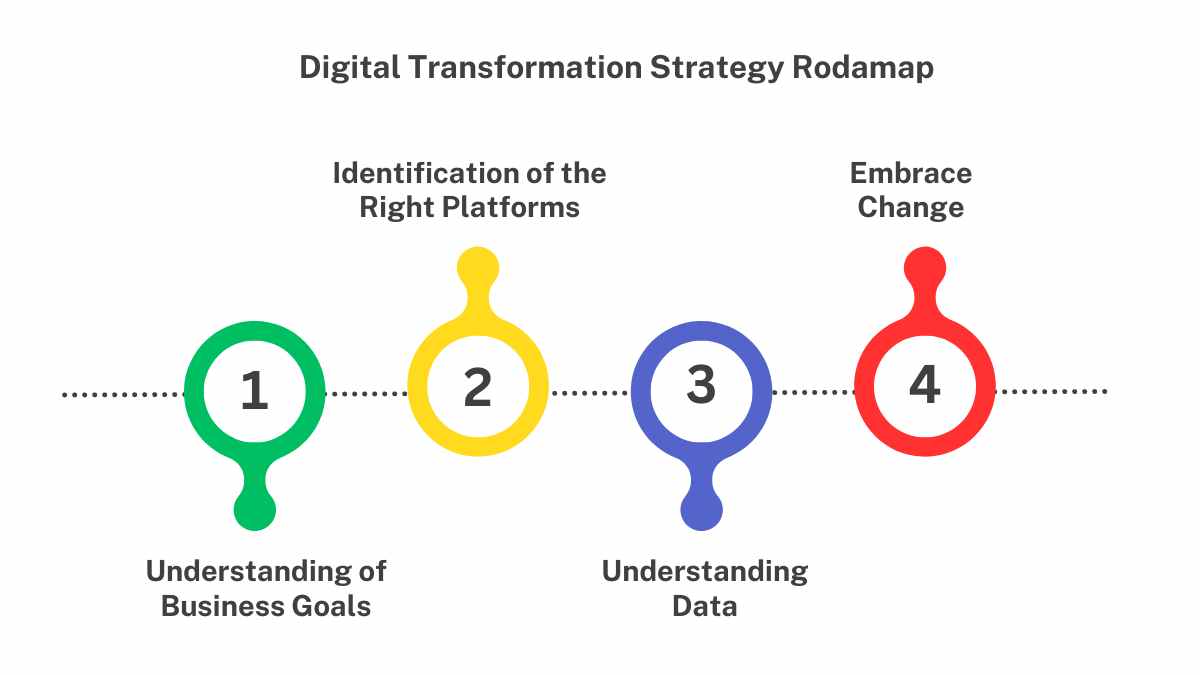
1. Understanding of business goals:
One of the essential strategies for successful digital transformation is to start with a clear understanding of your business goals and objectives. Digital transformation is not just about implementing modern technologies or digital tools. It is about leveraging technology to achieve your business goals, whether that is increasing revenue, improving customer experience, or optimizing operations. By having a sharp vision of what you want to accomplish, you can identify the right technologies and tools to help you achieve those goals.
2. Identification of the right platforms:
Another critical strategy for successful digital transformation is to identify the right technology platforms for your business. It requires many technologies and platforms, from cloud computing and data analytics to mobile applications and social media. It is crucial to choose the right platforms that align with your business objectives and integrate well with your existing systems. You should evaluate the cost and benefits of each platform and select those that offer the most significant value for your business.
3. Understanding Data:
Data is a core of digital transformation. To succeed in digital transformation, businesses need to leverage data to drive their decisions and actions. This requires a robust data strategy that includes collecting, storing, analyzing, and sharing data in real-time. You need to have the right tools and systems to manage your data effectively and ensure data security and privacy.
4. Embrace changes:
Another key factor is to empower employees to embrace the change. You need to provide them with the training and support they need to adopt innovative technologies and tools. You can also create a culture of innovation and experimentation that encourages employees to produce the latest ideas and solutions. Digital transformation is not just a technological change, but it is also a cultural change that requires the entire organization to embrace new ways of thinking and working.
Lastly, business leaders need to have a long-term vision for digital transformation. This means investing in the right technologies and platforms, hiring the right talent, and continuously monitoring and evaluating the progress of digital transformation. It is vital to be agile and adapt to changes in technology and the market to stay ahead of the competition.
Benefits of Digital Transformation
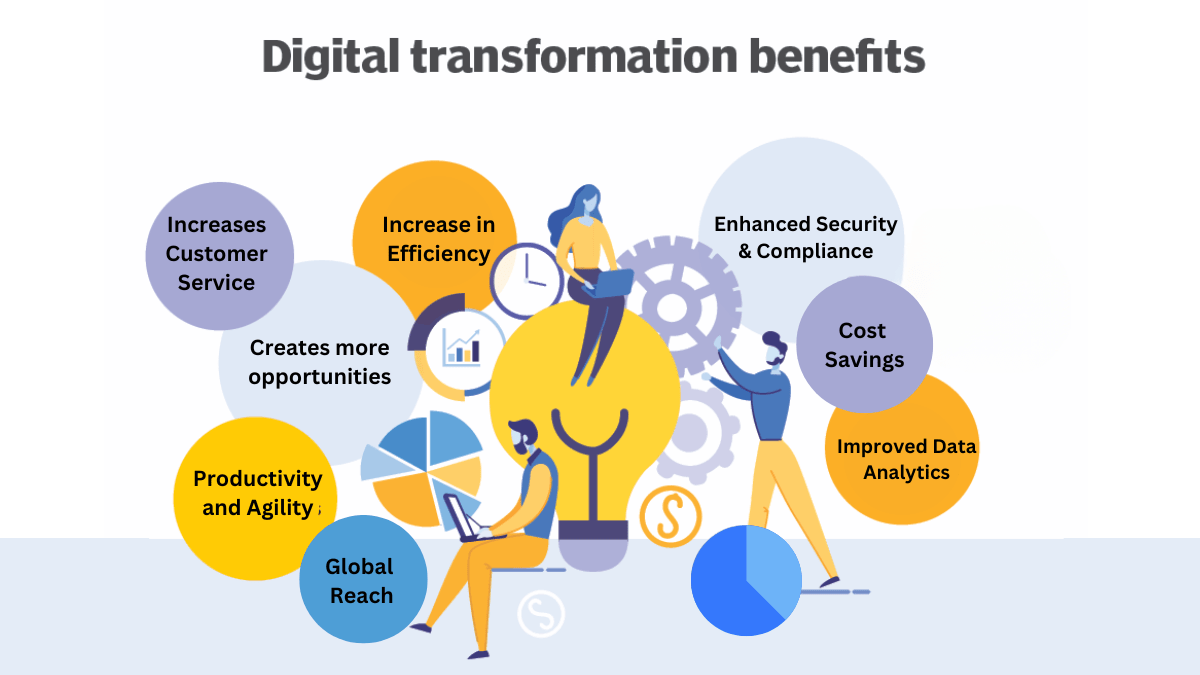
1. Increases Customer Service
Digital transformation techniques help in resolving customer issues in less time. Understanding the customer’s problem, making the best possible solution for it, and then getting back with the solution to the customer needs time. This is one of the reasons why customers are shifting to your competitor’s services. Since the customer needs quick and easy solutions to their problems. This problem can be reduced by making modern technologies part of your organization. We can use some tools such as online complaint forms or AI-based chatbots to provide solutions quickly to customers.
2. Creates more opportunities for customer engagement.
Digital transformation techniques give you plenty of chances and opportunities to connect with your customers. Different tools such as AI-based chatbots, and social media channels, can help you with customer engagement. Digital transformation techniques give you a more personalized way to connect with your audience. Modern technologies such as artificial intelligence, cloud computing, Internet of Things work well when it comes to engaging customers in four ways emotional, contextual, convenient, and social engagement.
3. Increase in Efficiency:
Automation and the use of technology streamline processes reducing the time and costs required to complete tasks significantly. Digital transformation in businesses also allows for real-time data visualization, reducing the possibility of errors and ensuring that resources are fully utilized.
4. Productivity and Agility:
Digital transformation enables businesses to be agile and responsive to changes that occur in the market as it allows for seamless integration between different departments, branches, and other systems. This results in improved collaboration, communication, and faster decision-making which boosts efficiency, and productivity and helps businesses to stay ahead of their competition.
5. Global Reach:
Technology has made it easier for businesses to reach out to customers worldwide. Digital transformation allows businesses to expand their reach beyond geographical boundaries, which further helps in identifying new opportunities.
6. Cost Savings:
Digital transformations result in reducing the overall overhead costs of business. Automation in work processes, paperless transactions, and digital storage options can help companies to save on costs. It can improve supply chain management and inventory tracking, further reducing the costs associated with buying and selling goods.
7. Improved Data Analytics:
Data Analytics enables businesses to access, manage and analyze vast amounts of data that span different departments and systems easily. This provides a better understanding of customer behavior, and preferences and can help businesses to identify trends and patterns, allowing for innovation.
8. Enhanced Security and Compliance:
Digital transformation ensures that data and customer information is secure and protected, making it easier for businesses to comply with laws and regulations associated with data handling and privacy.
Digital transformation has become an essential part of every successful business. As demonstrated, it can help businesses to redefine their operations and processes, improve their customer experience, reduce costs, and boost revenue. Therefore, businesses that want to remain competitive need to invest in digital transformation to unlock the numerous benefits that come with modern technologies.
Stages in Digital Transformation
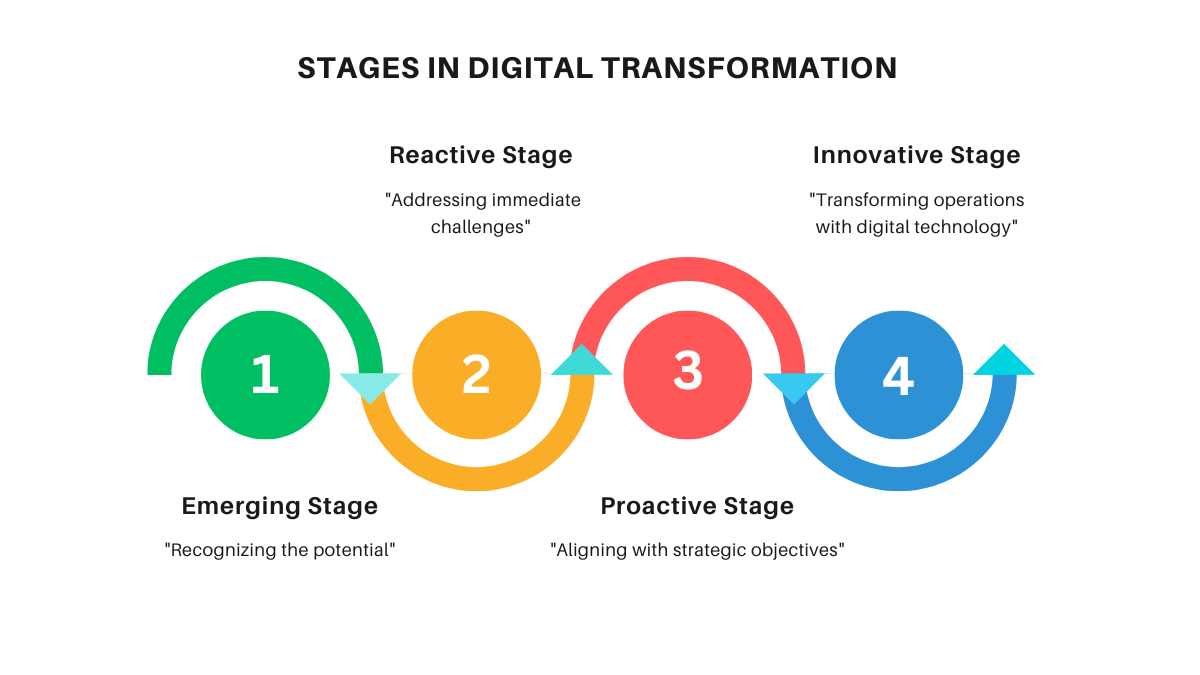
The world of technology is evolving. Digital transformation refers to the process of using digital technologies, services, and tools to fundamentally alter the operations and business model of an organization. It is an ongoing journey that takes different forms and happens in various stages depending on the level of maturity of an organization.
1. Emerging Stage:
The first stage of digital transformation is the Emerging stage. At this stage, organizations start to recognize the potential of digital transformation, but implementation is typically inconsistent. As a result, digital implementations are often experimental and focused on individual departments or projects. This stage is all about simplifying the existing process.
2. Reactive Stage:
At this stage, an organization begins to implement digital processes in response to specific challenges or opportunities. For example, if an organization faces immediate pressure to reduce operational costs, it may implement a solution to digitize and automate a specific process. However, as the reactive stage is focused on solving specific issues, digital projects often operate in isolation without considering the larger picture. As such, this stage is also characterized by fragmentation across the organization.
3. Proactive Stage:
At this stage, an organization begins to take a comprehensive approach to digital transformation, investing in digital initiatives that equate to strategic objectives. At this stage, an organization has begun to standardize its digital capabilities, allowing for more integrated and effective digital strategies.
4. Innovative Stage:
At this stage, an organization has transformed its operations through the integration of digital technologies, with digital technology becoming a central part of business strategy, culture, and decision-making. Digital transformation initiatives are strategic and collaborative, enabling organizations to respond to customer and market demands proactively. Innovative Organizations have transformed their business models, adopted a ‘digital first’ mentality, and continuously innovated to stay ahead of disruption.
The stages of digital transformation vary from organization to organization. Each stage marks a significant shift in the mindset and approach of an organization. The key takeaway is that unsuccessful digital transformation requires a strategic and coherent approach across the organization, with a focus on integrating digital technologies, processes, and people.
Use cases and examples of Digital Transformation:
Digital transformation has become a buzzword in recent years as businesses worldwide seek to revamp their operations to adapt to the digital world. Here are some case studies and examples of successful digital transformation.
1. Netflix
Netflix is an American entertainment company that has disrupted the traditional TV and movie industry with its subscription-based streaming service. Its users can watch shows and movies online for a monthly and yearly fee. One critical factor behind its digital transformation is its data-driven approach to content creation. It uses vast amounts of data to identify consumer preferences and create a personalized experience. This approach of Netflix has helped it to become one of the leading streaming platforms globally.
2. Johnson and Johnson
Johnson and Johnson is a multinational healthcare company that has embraced digital transformation in several ways. The company has developed multiple apps that are aimed at promoting wellness and chronic disease management. Johnson & Johnson’s Digital Health Leadership Program has also helped to train its employees to adopt innovative digital technologies. It also leveraged AI to streamline its supply chain and operations.
3. Amazon
Jeff Bezos founded Amazon in 1994 as an online bookstore, but today Amazon sells everything from books to groceries. One key factor that fueled Amazon’s digital transformation was its commitment to customers. Amazon’s data-driven approach to customer service has become legendary in the world of e-commerce. Amazon’s prime program, for example, is a loyalty program that offers free shipping, video streaming, and other rewards to customers. The company’s digital transformation strategy also integrated artificial intelligence, machine learning, and other technologies to deliver personalized service to customers. Amazon’s digital transformation has helped it to become one of the world’s most valuable companies.
4. Airbnb:
It has transformed the hospitality industry with its unique methods of sharing homes and properties. Airbnb made us easy to enjoy a home-like stay in foreign cities or towns while exploring new locations. Airbnb has harnessed user-generated content and big data, such as ratings and reviews to build a reliable and transparent platform for its users. The use of digital technologies has enabled Airbnb hosts to manage properties, pricing, and bookings seamlessly.
5. Uber:
It has transformed the traditional taxi industry with its innovative platform. Its ride-hailing app matched riders and drivers through GPS tracking, providing an easy and affordable mode of transportation. Uber has also incorporated payment integration, ensuring that cashless transactions make payment effortless and secure.
Also Read: Why is Now The Perfect Timing for Digital Transformation in Financial Services?
Why do Digital Transformation projects fail?
Digital Transformation projects have become a necessity for businesses in the Digital age, yet they still face a high rate of failure.
The reasons for failures in Digital transformation may vary, but here are the top reasons why these projects fail.
Lack of understanding of Objectives:
Digital transformation projects fail when companies initiate their strategy without a clear understanding of goals and objectives. In this case, it makes the process of measuring success difficult. Organizations that lay out clear objectives for their Digital Transformation project have a higher chance of success.
Resistance to change:
Resistance to change is another common reason Digital Transformation projects fail. Employees who are reluctant to embrace the change need to suffer more. They are likely to attach more to the old methods and resist new ways of doing things. Educating the workforce and creating a culture that is open to change is critical for any Digital Transformation project to succeed.
Lack of leadership Support:
Digital Transformation is not just about implementing innovative technologies, it is about changing the way of working and updating the processes. When there is a lack of leadership support, the project team may find it challenging to get the resources, the budget, and the stakeholder collaboration. Leadership involvement in the project is key to its success.
Inadequate Resources and Budget:
Digital Transformation projects require significant resources and financial investment to be successful. A lack of budget and resources can lead to incomplete projects, which may not meet the desired goals. Organizations need to allocate adequate financial resources and have qualified people to manage the project.
Lack of Expertise:
Digital transformation is a complex process that requires expertise from different fields, including technology, business, and management. Companies that lack expertise in these areas are likely to fail more. Organizations must have experts involved in the projects to ensure their success.
Conclusion:
Digital Transformation is an iterative process that requires organizations to integrate emerging technologies into their operations. As such, organizations must invest in transforming their business processes and models to stay competitive in today’s rapidly evolving digital landscape.
Contact us if you want to know more about our digital transformation services. We are one of the best Digital Transformation consulting firms as we have a team of Digital Transformation experts and the latest tools.
Supercharge Your Marketing Strategy with Our Digital Marketing Services
Let us help you elevate your brand and reach your target audience with our comprehensive digital marketing services.
Frequently asked questions
1. What are the four principal areas of digital transformation?
The four primary areas of digital transformation are:
- Process Transformation.
- Business Model Transformation.
- Domain Transformation.
- Cultural/Organizational Digital Transformation
2. What are some examples of Digital Transformation?
Ans) Some Digital Transformation examples are:
- IKEA
- LEGO
- NIKE
- DISNEY
- MICROSOFT
- AUDI
3. Why is Digital Transformation crucial in business?
Digital transformation comes with many advantages to your business:
- Increases efficiency.
- Increases business agility.
- Increases customer relationships.
- Encourages Collaboration
- Minimize human error.
- Enables software monetization.
4. What is currently driving Digital Transformation?
Some key drivers in digital transformation are software as a service, responsive web developments, and cloud-native applications.
5. What is a Digital Transformation roadmap?
The Digital Transformation roadmap’s purpose is to provide a complete guide toward transformation. It involves all the details including the current situation and future goals of the company.








